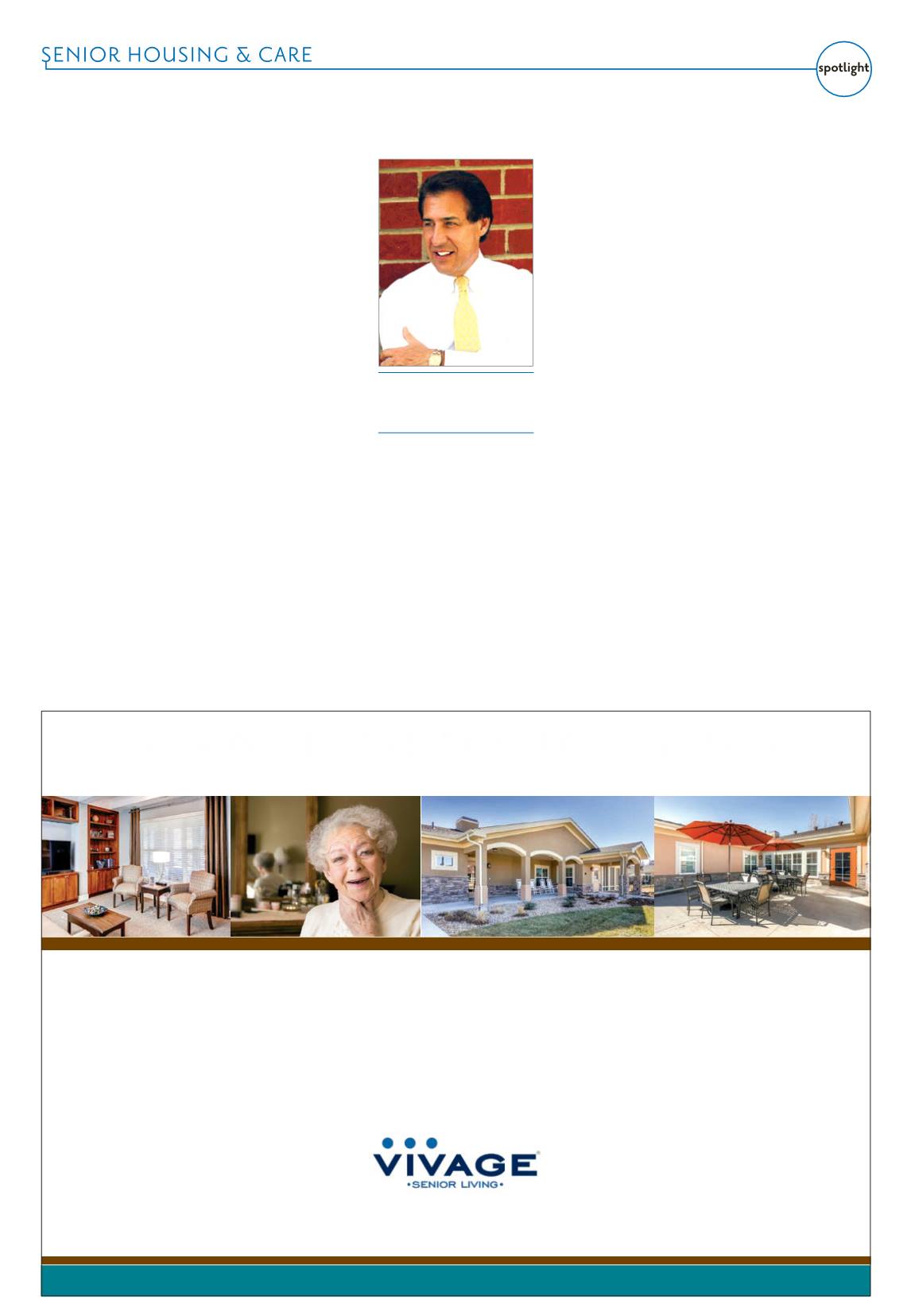
April 20-May 3, 2016
—
COLORADO REAL ESTATE JOURNAL
— Page 5B
Colorado’s Leader in Senior Living Quality and Innovation
Recognized expertise in memory care, rehabilitation services, and tailored approaches to
hospitality, optimal health and wellness, and select high quality housing options.
12136 W. Bayaud Ave. #200 Lakewood, CO 80228 303.238.3838
VIVAGE SENIOR LIVING
Full Management Services • Consulting Partner • New Development & Design Collaboration • Market Positioning
We create models that reflect exciting lifestyle choices for today’s seniors.
F
or the first time since
the nursing home
construction boom
that occurred after Congress
passed the Medicare/Medicaid
Act in the 1960s, there is high
demand for new construction
and repositioning of nursing
facilities, and a new focus on
the physical environment. What
is fueling this new demand?
Two things. First, the average
nursing home in America is
over 45 years old and most
of these older facilities are
obsolete with regard to values
and expectations that newer
generations of seniors and
their families have for their
environments. The second
reason for this increase in
construction activity is that
developers and providers have
ready access to capital. Because
of high performance in the
senior industry that occurred
after the recession, money is
available through real estate
investment trusts, commercial
banks, U.S. Department
of Housing and Urban
Development, and private
equity investors.
n
Meeting consumer
desires.
While nursing home
usage has remained flat or
receded in recent years, skilled
nursing is still an important
part of the continuum of
care. The population is
aging and the demand for
short-term rehabilitation
beds is increasing. Given
the obsolescence that exists
in the industry, developers
and providers find that new
and repositioned facilities
can capture a significant
number of the available short-
term Medicare-reimbursed
rehabilitation patient that
aches for a better physical
environment and a better
home like experience than
the “old nursing home”
provides. This is an important
part of the formula because
the Medicare resident and its
reimbursement rates is the fuel
that drives new development
feasibility. “Build it and they will
come” is an appropriate axiom
today but only if you build to
satisfy ideals that seniors and
families have for their living
and care environment. Several
companies are experiencing
success building new models
that are responsive to desires
and expectations of today’s
seniors and their families.
Mainstreet, based in Carmel,
Indiana, has built 25 new
projects in five states, including
Colorado, and has another 50
projects under development
in 11 states. Wellbrooke of
Westfield, Genesis Power
Back Rehabilitation Centers
and Welbrook Senior Living
also are examples of other
for-profit providers that have
multiple new facilities recently
completed and in development.
While 75 percent of investment-
grade nursing homes are
owned by for-profit providers,
hospitals and other traditional
nonprofit providers also are
active in the development
arena. Adventist Care Centers,
for example, after a 15-year
hiatus from the building
business, is developing four new
freestanding nursing facilities
with a 50-50 mix of long-term
and short-term care and is
repositioning eight existing
facilities to respond to the need
for more short-term beds and
the need for more responsive
interior environments that
align with consumer desires.
n
Best practices and market
preferences.
So what are these
providers building and what
are some of the best practices
in facility design to respond
to today’s market? First, it
is important to note that in
facilities with both short-term
and long-term care populations,
these two user groups are very
different in age, purpose of stay
and length of stay. Consider
that for the long-term care
population, who are among the
oldest in the continuum, this
is their home and the interior
environment should reflect and
personify the image scale and
function of home. The short-
term population, whose average
stay is 15 days and which
includes some of the youngest
seniors in the continuum, are
expecting more of a hospitality
experience in terms of service
and environment. Many
providers call this population
“guests” instead of “patients”
or “residents,” which bears out
this new paradigm. Here are
some programming and design
practices utilized in this new
generation of nursing home.
• For facilities with both
short-term and long-term care,
provide separate entrances and
separate interior living social
and amenity spaces to avoid
mixing these two populations.
• Utilizing lessons learned
from the assisted-living industry,
de-scale and de-institutionalize
the environment by eliminating
long corridors. Design the
building with “neighborhoods”
that have individual
neighborhood great rooms,
dining areas, activity areas,
family niches and guest areas.
Providing direct access to the
outdoors from these areas,
reinforce both a residential and
a hospitality intent.
• Design for an abundance
of natural light throughout
the building. This, along with
views and access to nature and
the outdoors, are evidenced-
based concepts for healing
environments and part of a
healthful and therapeutic living
and healing pattern. Therefore,
create strong indoor/outdoor
connections along with a variety
of outdoor spaces including
protected, shaded and covered
areas that are habitable,
accessible and stimulating.
• Provide hotel-like private
rooms with desks for personal
computers; large, flat-screen
TVs; and built-in closets,
dressers and adequate seating
for visits by family and friends.
• For both levels of care,
provide a variety of spaces
within the building that are
designed to invite family,
friends and the community-
at-large. Bistros, grab-and-go
food options, theaters, outdoor
kitchen and dining experiences
and flexible activity spaces are
all examples of these kind of
programming ideas.
• Include provisions for
higher levels of technology to
appeal to a more tech-savvy
resident. Utilize technology to
enhance health care services as
well as the service-on-demand
Dennis Boggio
President, Lantz-Boggio Architects,
Denver


